Abstract
Next-generation passive optical networks (NG-PONs) are considered an essential solution for optical architectures, owing to the benefits of energy savings, service transparency, supporting several subscribers, and cost-effectiveness. In this work, a linearly polarized (LP [0,1]) modal bidirectional NG-PON using a graded-index multimode fiber (GIMMF) and free space optics (FSO) is realized. Four downlink/four uplink wavelengths are utilized under the impact of GIMMF nonlinearity, lens losses, and noise with a 100 m FSO link under clear air and weak turbulence. The results depict that a reliable 5.5 km range is obtained at an aggregate symmetric data rate of 40 Gbps. Also, the minimum focal length and lens reflectance of 0.085 m and 12–14.5% in the downlink as well as 0.08 m and 17–19% in the uplink are required, respectively, for a 10−9 bit error rate over a 5 km range. It is also realized that the generated LP modes offer an optimum power fraction of 0.52 to ~1 × 10−11 in the downlink and 0.53 to 1 × 10−10 in the uplink and phase values of 0.23 to 4.79 rad in the downlink and 0.96 to 5.81 rad in the uplink direction. Compared to other systems, the proposed design shows optimum performance and offers a −25.47 dB gain, a 28.84 dB noise figure, a −18.46 dBm output signal, and a 30.51 dB optical signal-to-noise ratio.
1. Introduction
The increasing requirement for high-speed, cost-effective data streaming owing to end users’ exponential growth has been appearing as a big issue for microwave and radio frequency (RF) transmission networks. It occurs owing to last-mile challenges, lack of infrastructure, and regulatory issues. Because of the growth of throughput, it is considered that the RF spectrum will be depleted in the incoming years. The utilization of the optical spectrum will have a considerable potential to fulfill the constantly expanding requirements for this high-speed throughput [1]. Moreover, the demand for high-speed internet traffic, which is contemporarily attributed to the increasing popularity of 5G applications, big data, and cloud computing, is in high demand. To withstand this challenge, optical communications are widely developed, where the current deployments are primarily based on optics [2]. Free space optics (FSO) communication is a widespread technology that incorporates laser beams to transmit information via air. It is a cost-effective, fast-deploying fiber alternative technology for when fiber cables are impossible to install [3]. In FSO systems, data-carrying beams can be affected by distinct impairments, like limited-size receiver aperture, atmospheric turbulence, ink misalignment, or obstructions [4].
During the last few years, the formation of new market needs for Internet and telecom data services has driven research in fiber optics to develop through multiple stages. Indeed, the transmission capacity of fibers has seen an exponential rise in multiple dimensions. Enhancements have been achieved through multi-wavelength, polarization, and modulation techniques [5], although single-mode fiber (SMF) channel capacity has verged on the nonlinear Shannon limit. The emergence of mode division multiplexing (MDM) has been influential in overcoming the issues of traditional fiber transmission. MDM incorporating multimode fibers (MMFs) has been shown to significantly enhance transmission capacity, but mode coupling-generated crosstalk remains a primary issue in MDM transmission using MMFs, necessitating a costly as well as complex digital signal processing system for valuable mitigation [6].
Furthermore, passive optical networks (PONs) have been appraised as the most economical technology in the deployment of fiber access networks. PON provides extensive benefits upon fiber-to-the-x architecture deployment. It offers internet connectivity from an optical line terminal (OLT) in a downlink (DN) transmission to optical network terminals (ONTs) at the consumer’s side as a point-to-multipoint architecture. Other advantages incorporate high-quality broadband access, energy-efficient deployment, high-speed internet services, and data services in an economical manner [7]. The current Ethernet PON and Gigabit PON usually offer a 1.25 or 2.5 Gbps data rate. Additionally, current next-generation PONs (NG-PONs) based on 10G Ethernet PON and 10G Gigabit PON networks upgrade the data rate to up to 10 Gbps per wavelength [8]. Despite the listed benefits, PON architectures tend to be influenced by network issues, mainly in the channel capacity of PON networks in optical distribution networks (ODNs), which is regarded as more conquerable [7].
Also, comparing the data transmission over multi-SMFs, PON-FSO permits the minimization of power consumption and the upgrade to an existing single-mode scenario, which provides cost-effectiveness in PON applications [9].
1.1. Related Work
The past ten years have witnessed the standardization and development of PON architectures by IEEE and ITU-T. In [5], a graded-index few-mode fiber (GI-FMF) encourages twenty eigen modes with higher intermodal separation between vector modes. It encourages 12 orbital angular momentum (OAM) modes in GI-FMF. It is realized that the shape parameter is a suitable candidate for short-haul communication [5]. In [10], 20 OAM modes at a 10 Gbps per channel data rate are realized over a free space optics (FSO) link range of 0.4 m at a 10−3 bit error rate (BER) using an erbium-doped fiber amplifier (EDFA) [10]. In [11], PONs and orthogonal frequency division multiplexing (OFDM) systems using wavelength division multiplexing (WDM) for facilitating the dense deployment of 5G networks are realized. It shows that the reliable FSO range of 3 km is obtained at a 10 Gbps transmission rate for 512 subcarriers. In [12], an MDM system using a four-quadrature amplitude modulation is realized over a 10 m fiber at a 10 Gbps data rate. Six linearly polarized (LP) modes, viz., LP01, LP11a, LP11b, LP21a, LP21b, and LP02, are generated in the system along with EDFA. In [13], WDM and OAM modes are presented over a 1 km MMF at a 10 Gbps transmission rate. In [9], a time division multiplexing (TDM) PON using an MDM scheme is demonstrated over a 10 km few-mode fiber (FMF) and a 10 km SMF at a 10 Gbps data rate. In [14], an MDM-PON system incorporating a 10 km two-mode fiber at 10 Gbps is realized successfully.
For these types of optical networks, there is an encouragement to further enhance the system capacity of existing PON communication links by utilizing multiplexing and FSO links. In a modal transmission scenario, multiple transmission beams carrying an individual data channel are coincidentally transmitted in the same wavelength spectrum.
1.2. Motivation and Contributions
In the proposed integrated NG-PON-FSO system, each beam with a phase profile and structured amplitude has one of N orthogonal modal basis modes. This orthogonality offers the multiplexing, demultiplexing, and spatial co-propagation of each independent data channel with low inherent crosstalk. A single LP[0,1] mode is used for the investigation, as the higher-order LP modes influence the communication compared to first-order modes. Inspired by this motivation, the proposed work contributions are described as follows:
- An LP modal bidirectional and symmetric NG-PON-FSO system is designed.
- System performance is investigated for uplink and downlink transmission under the impact of a graded-index multimode fiber (GIMMF), link losses, and receiver noise.
- A comparative analysis of the proposed design with the existing ones is presented.
This work is organized as follows: The proposed design, simulation parameters, generated modes, and optical spectra of various wavelengths are described in Section 2. Section 3 presents the evaluated results together with the analysis. Section 4 and Section 5 illustrate a discussion and summarize the conclusion, respectively.
2. Proposed Design
Figure 1 indicates the simulation setup of the proposed LP modal bidirectional NG-PON system using a GIMMF-FSO link.
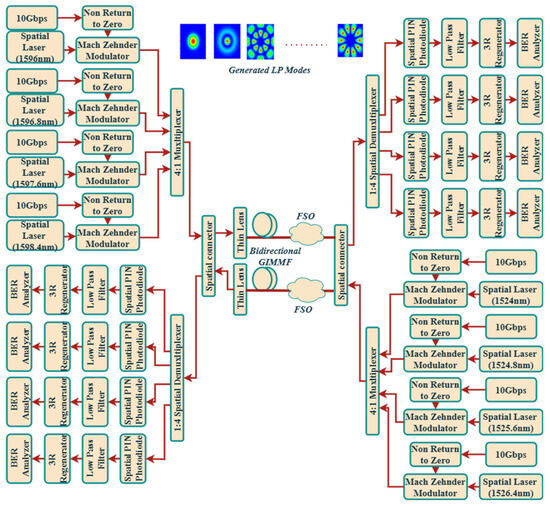
Figure 1.
Proposed architecture of LP[0,1] modal bidirectional 4×10 Gbps NG-PON system using two GIMMF-FSO fibers.
An ITU-T-standardized NG-PON is realized in the proposed work, which incorporates a set of four downlink and uplink wavelengths at an aggregate data rate of 40 Gbps. For these specified wavelengths, a 0.8 nm channel spacing is used as per the ITU-T standard (G.989 series). In the proposed system, the TIA-492AAAB standard OM2 MMF is used at a 2.6 dB/km attenuation. The LP[0,1] mode is used to transmit the bidirectional data at distinct operating wavelengths. The proposed LP modal NG-PON-FSO system using a GIMMF link is designed in the OptiSystem v.22 simulation tool under the impact of fiber nonlinearity, link losses, and receiver noise. A spatial optical laser at 1596 to 1598.4 nm is utilized as an input source for modulation in a Mach–Zehnder modulator. Random non-return-to-zero signals are generated at a 10 Gbps data rate for both the downlink and uplink transmission. Four modulated downlink signals, viz., 1596, 1596.8, 1597.6, and 1598.4 nm, passed through a 4:1 multiplexer to launch into a spatial connector followed by a thin lens. The spatial connector (for precisely aligned, rotation = 00, distance = 1 µm, and X/Y shift = 0 µm) connects signals with transverse mode profiles, which can be rotated and translated. This device ensures the efficient coupling of signals between distinct spatial paths in fiber-FSO links. The thin lens used at the transmitter helps to collect the photons transmitted by laser diodes and then forward them to GIMMF [15].
To minimize the modal crosstalk in a single MMF fiber and for bidirectional transmission, two separate GIMMF cables with FSO links are used for the downlink and uplink transmissions. At the ONT end, a 4:1 demultiplexer is used to distribute the received signals to a distinct spatial PIN photodiode, followed by a low-pass filter and a 3R regenerator. The system performance is evaluated in a BER analyzer. Likewise, for the uplink transmission, four distinct wavelengths, viz., 1524, 1524.8, 1525.6, and 1526.4 nm, are utilized for data transmission from OLT to ONU at an aggregate 40 Gbps data rate.
Various generated modes after data transmission through GIMMF are presented in Figure 2. Here, the specified sixteen LP modes are considered as follows: LP[0,1], LP[0,2], LP[4,2], LP[4,1], LP[−5,2], LP[5,2], LP[3,2], LP[−3,2], LP[−5,1], LP[5,1], LP[1,2], LP[−1,2], LP[−3,1], LP[3,1], LP[1,1], and LP[−1,1].

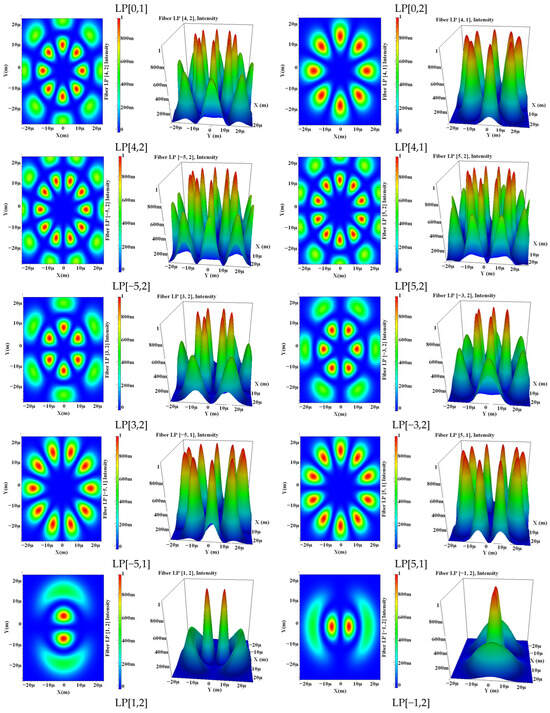
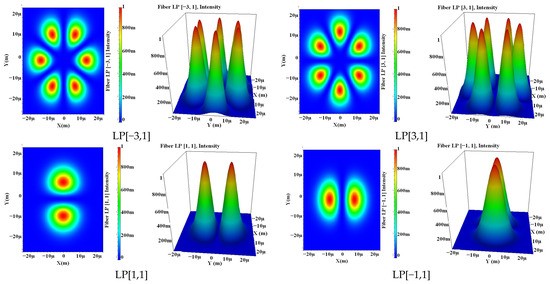
Figure 2.
Generated mode plots in the proposed system.
In MDM-based fiber-wireless systems, the LP[0,1] mode is generally preferred over higher-order LP modes, as it offers minimal modal dispersion, low attenuation, and resistance to turbulent environments. The fundamental LP[0,1] mode exhibits lower propagation loss, less turbulence-induced coupling, less diffraction, and a legible beam structure for long transmission distance compared to higher-order modes. It also faces less dispersion, maintains confined intensity distribution, and leads to narrower beam propagation compared to higher-order modes. Better system performance is obtained by using the LP[0,1] mode, followed by LP11, LP21, LP31, and other modes.
The system is proposed and investigated in OptiSystem, and its parameter specifications are depicted in Table 1.

Table 1.
Simulation specifications [16,17].
3. Results and Analysis
The proposed design is investigated in the OptiSystem simulation software. The system’s performance is evaluated for four downlink wavelengths (1596, 1596.8, 1597.6, and 1598.4 in nm) and four uplink wavelengths (1524, 1524.8, 1525.6, and 1526.4 in nm) at the LP[0,1] mode. Clear air and weak turbulence under the Gamma−Gamma model are considered. The atmospheric turbulence and different weather conditions can lead to several detrimental effects, like beam wander, optical loss, angular fluctuation, and received-signal fluctuations, which result in a deteriorated system performance and an increase in BER. Additionally, atmospheric turbulence arises owing to wind pressure and temperature gradients causing random air density fluctuations, temporal phases, and spatial distortions in LP modal systems. In optical networks, the BER is a dominant performance metric, which quantifies the bit error probability owing to interference and noise over a fiber-FSO channel.
The BER performance of the system is expressed as follows [18]:
where means complementary error function. In the GIMMF link, losses are generated owing to four-wave mixing effects in the fiber, which is quite less compared to other systems where the bidirectional fiber is used instead of separate fibers. However, the GIMMF link enhances the system’s capacity. Four-wave mixing (FWM) is a nonlinear optical effect that occurs in multi-wavelength systems. Due to the interaction of multiple optical signals in an optical fiber, new frequency signals are generated. The FWM effect degrades the system’s performance by introducing crosstalk and unwanted interference.
Mathematically, generated FWM wavelengths are expressed as follows [19]:
and the number of generated FWM wavelengths are described as follows [19]:
As shown in Figure 3a,b, multiple wavelengths are generated in addition to the main four lobes for both the downlink and uplink transmissions. Here, the launch power of 10 dB decreases to −10 and −5 dBm after transmission in the DN and UP directions, respectively, over a 5 km fiber and a 100 m FSO link. The maximum number of generated modes due to FWM in the DN and UP directions is three at a −100 dB noise floor. It is also depicted that the DN transmission is more susceptible to the FWM effect compared to the UP transmission, as L-band (1565–1625 nm) wavelengths are more affected by fiber nonlinearity compared to C-band (1530–1565 nm) wavelengths.
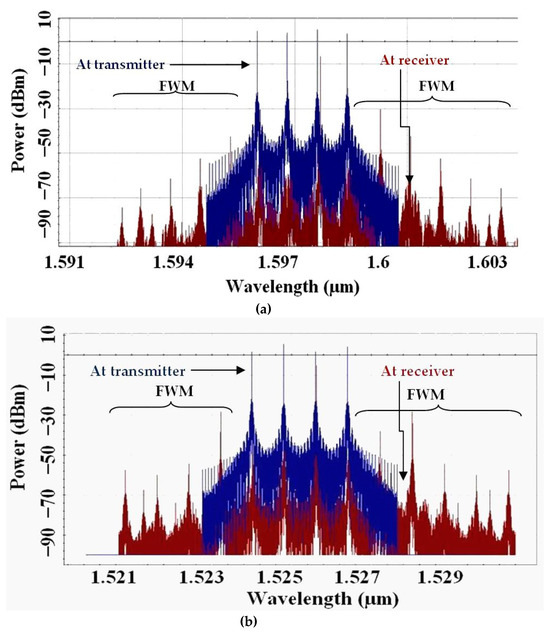
Figure 3.
Obtained spectra at 10 dBm input power for (a) downlink and (b) uplink transmission over a 5 km range.
Figure 4a,b depict the BER performance of all downlink and uplink wavelengths operating at the LP[0,1] mode at a 10 Gbps per channel data rate. As shown in Figure 4a, the BERs of all downlink wavelengths are below the 1 × 10−9 BER limit when the distance is not more than 5.5 km at 1596 nm, 5.45 km at 1596.8 nm, 5.4 km at 1597.6 nm, and 5.47 km at 1598.4 nm. Also, for the uplink wavelengths, viz., 1524, 1524.8, 1525.6, and 1526.4 nm, the reliable GIMMF distance is 5.5 km, as shown in Figure 4b. The results demonstrate the successful transmission of the four downlink and four uplink signals, showing the considerable potential to enhance the communication capacity of PONs. For the 1524 nm wavelength, deviation in the BER performance is obtained owing to the impact of atmospheric effects (air and weak turbulence), modal dispersion, inter-symbol interference (ISI), geometric loss, and fiber nonlinearities over the large coverage.
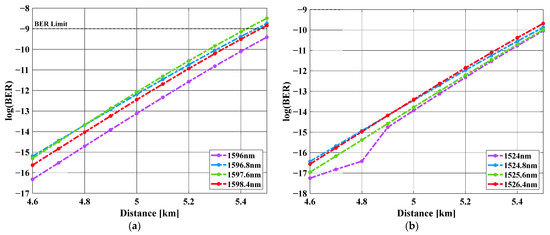
Figure 4.
Distance vs. BER of (a) downlink and (b) uplink transmission.
With the increase in fiber distance, the signal quality deteriorates owing to the impact of MMF fiber nonlinearity, spatial connectors, and thin lens losses. The sharp increase in BER at 1597.6 nm beyond 5.4 km is due to the presence of fiber nonlinearities, dispersion, and atmospheric absorption in the free space. The longer wavelengths (at 1597.6 nm) in the L-band lead to increased fiber attenuation, chromatic dispersion, self-phase modulation, stimulated Raman scattering, and FWM. The fiber nonlinearities lead to increased pulse broadening, signal distortion, interference, a high error rate, and a low SNR. Also, in FSO, the accumulated absorption loss causes significant power loss, modal crosstalk, and power fluctuations near 1600 nm, causing a high BER.
The results obtained by varying the GIMMF fiber distance in both the downlink and uplink wavelengths are shown in Table 2.

Table 2.
Summarized results for varied fiber length for various wavelengths.
The eye patterns for distinct downlink and uplink wavelength channels operating at the LP[0,1] mode are depicted in Figure 5. After the transmission over a 5 km distance, the signals become worse compared to the signal. However, low modal crosstalk is observed at the fundamental LP[0,1] mode; thus, clear as well as open eye patterns are observed.


Figure 5.
Eye patterns for different downlink and uplink wavelengths at a 5 km distance.
Figure 6a,b depict the performance of the LP modal NG-PON system using a GIMMF-FSO link at varied focal lengths of the lens for downlink and uplink transmission, respectively. These figures express that higher system performance is achieved (BER ≤ 10−9) to transmit bidirectional signals in the GIMMF channels when there is an increase from 0.08 to 0.125 m over a 5 km distance. Here, an acceptable BER is observed for more than a 0.085 m focal length in the downlink and 0.08 to 0.085 m in the uplink direction, as shown in Figure 6a,b, respectively. To further enhance the system’s performance in terms of transmission distance, channel capacity, and transmission speed, an additional receiver lens can be incorporated. However, it is quite challenging to obtain an omnidirectional and flexible transmission by increasing the focal lens and using more lenses. It also shows that longer distances would require sophisticated optical beam coupling schemes at both the transmitter and receiving sides to reduce the beam size and attain lower loss coupling from the wider beam [20]. Nevertheless, the near-infrared 1524 nm wavelength faces minor chromatic dispersion effects, thermal deformations, small beam divergence, and fewer surface imperfections; thus, BER deviations are observed at a larger focal length of the lens. Figure 7 depicts the eye patterns of different wavelengths at a 0.085 m focal length of the thin lens.
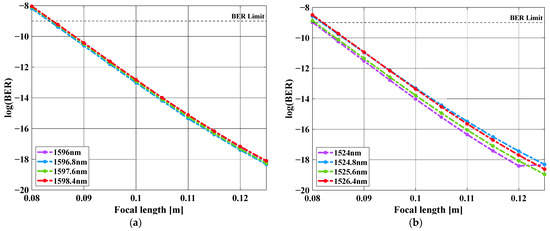
Figure 6.
Focal length vs. BER of (a) downlink and (b) uplink transmission.
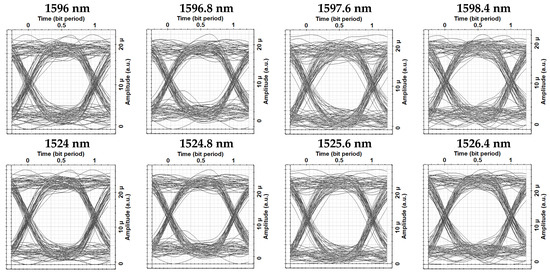
Figure 7.
Eye patterns for different downlink and uplink wavelengths at a 0.085 m focal length.
Figure 8a,b depict the performance of the LP modal NG-PON system at varied lens reflectance values for downlink and uplink transmission, respectively, at the LP[0,1] mode. The phase transformation of the lens is considered basic Fourier optics. It is utilized to derive the lenses’ wave transform properties, propagation models, and a diffraction analysis. For a thin lens, the phase transformation is expressed as follows [21]:
where is the focal length, is the operating wavelength, and and means lens dimension. Note that higher lens reflectance linearly decreases the system’s performance in terms of BER. For a downlink transmission with a 5 km fiber distance, the evaluated reflectance is 14.5% at 1596 nm, 13% at 1596.8 nm, 12% at 1597.6 nm, and 13% at 1598.4 nm, as shown in Figure 8a. Meanwhile, for the uplink transmission with the same distance, the reflectance values increase to 19%, 18%, 17.5%, and 17% at the 1524, 1524.8, 1525.6, and 1526.4 nm wavelengths, respectively, as depicted in Figure 8b. It is realized that at 1524 nm, the system undergoes BER deviation compared to other wavelengths, owing to the impact of temperature-induced variations, material non-uniformity, interference effects, and Fresnel reflection alternations at a high lens reflectance. Table 3 depicts the summarized results for both the downlink and uplink transmission for varied lens reflectance values.

Figure 8.
Lens reflectance vs. BER of (a) downlink and (b) uplink transmission.

Table 3.
Summarized results for varied lens reflectance values for different wavelengths.
Figure 9a,b depict the system’s performance in terms of the GIMMF mode versus the coupling coefficient for the downlink and uplink wavelengths at the LP[0,1] mode. The fiber range of 4.5–5.5 km with an aggregate symmetric data rate of 40 Gbps is presented. For all operating wavelengths, the lowest power fractions of ~10−11 in the downlink and 10−10 in the uplink are observed for the higher-order modes, viz., LP[1,1] and LP[−1,1]. At the fundamental LP[0,1] mode, the maximum power is received, i.e., 0.52 in the downlink and 0.53 in the uplink. Meanwhile, after the LP[0,2] mode, the fraction of power decreases sharply for LP[4,2] until ~1 × 10−7 in both the uplink and downlink transmission. Additionally, the corresponding phase value for each LP mode decreases from the LP[0,1] to the LP[−1,1] mode, as depicted in Figure 9a,b. Here, the LP mode phase changes from 0.23 to 4.79 rad in the downlink and 0.96 to 5.81 rad in the uplink. Higher-order LP modes lead to fluctuations in the power penalty among the diverse LP modes, owing to scattering losses and fiber nonlinearity [22].
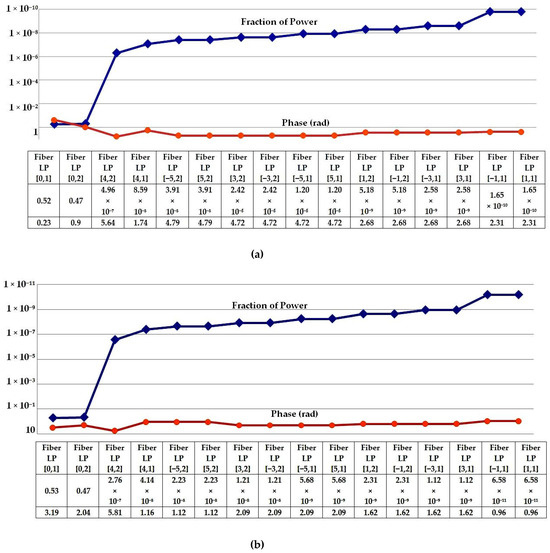
Figure 9.
Observed fraction of power and phase performance for (a) downlink and (b) uplink transmission.
Figure 10a–d depict the system’s performance analysis for a varied fiber range from 4.6 to 5.5 km for both the downlink and uplink transmission. In an optical network, high gain is used to compensate for the fiber losses; a low noise figure and a high OSNR signify better signal quality at the receiver side. Mathematically, gain, noise figure, and OSNR are described as follows:
and
and
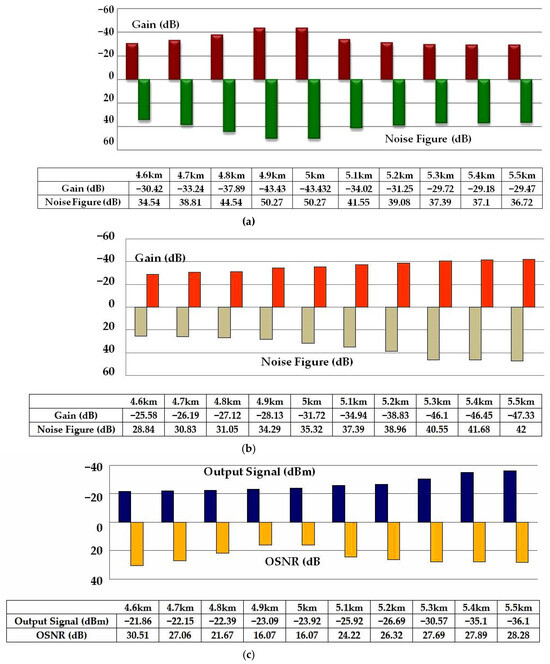
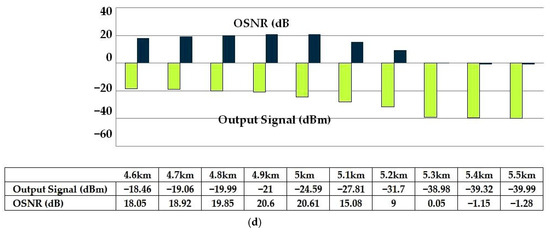
Figure 10.
System performance with respect to gain and noise figure for (a) downlink and (b) uplink transmission; output signal and OSNR for (c) downlink and (d) uplink transmission.
For the downlink transmission, the system gain varies from −30.42 to −29.47 dB, and the noise figure varies from 34.54 to 36.72 dB, as depicted in Figure 10a. For the uplink transmission, the gain and noise figure range from −25.58 to −47.33 dB and 28.84 to 42 dB, respectively, as shown in Figure 10b. Also, the −21.86 to −36.1 dBm and 30.51 to 28.28 dB values are obtained for the downlink output signal and the optical signal-to-noise ratio (OSNR), respectively, as shown in Figure 10c, while for the uplink transmission, the values of −18.46 to −39.99 dBm and 18.05 to −1.28 dB for the output signal and OSNR are received, respectively, as depicted in Figure 10d.
4. Discussion
Optical wireless and wired communication systems will continue to speedily evolve, both in terms of capabilities and architectures, to carry the surge in various applications, like tele-surgery, augmented reality/virtual reality, industry automation, intelligent transport systems, etc. PONs have expanded over the years in respect of their hardware, architecture, capacity, underlying protocols, and algorithms. It is estimated that 40% of the world’s population will possess a fiber-to-the-x link reach of 22.4 B by 2026 [23].
In comparison to experimental work operating over the C-band at a 10 Gbps data rate [16], the proposed work offers high channel capacity and spectral efficiency at a high data rate of 40 Gbps over the L/C-band. The proposed work indicates that GIMMF can be utilized in metro transmission with better nonlinearity tolerance compared to existing work, as shown in ref. [16], for its large effective mode-field coverage. Moreover, compared to LP[0,1] modal simulation work operating at the 1552.52 and 1550.12 nm wavelengths in [17], the proposed design offers a reliable GIMMF range of 5.5 km at a BER of 10−9.
Table 4 shows the comparative analysis of the proposed architecture with respect to previous works. The proposed system is realized under the impact of 5.5 km GIMMF nonlinearity, lens losses, and noise with geometric and free space path loss of a 100 m free space link under clear air and weak turbulence. It depicts the comparative analysis of the proposed work in terms of transmission distance, number of supported channels, throughput, and link distortions, including environmental conditions, spectral efficiency, and flexibility.

Table 4.
Comparison analysis with respect to existing works.
However, the proposed bidirectional NG-PON system using integrated GIMMF-FSO offers a higher channel capacity (=4 × DN/UP wavelengths), a high data rate (=4 × 10/10 Gbps), a simple design, and cost-effectiveness. This system offers optimum results under the impact of fiber nonlinearity, lens focal length, reflectance, and noise compared to other existing systems without using any amplifiers, but it also suffers from a limited transmission range due to a tradeoff between distance and traffic rate.
GIMMF is cheaper compared to SMF, owing to manufacturing tolerances, a larger core size, and requiring multimode transceivers instead of precise transceivers for SMF. GIMMFs are easier to install, pose fewer installation costs, and require cost-effective splicing and connector equipment. Also, GIMMF is useful for multimodal and short-range applications but has bounded scalability owing to modal attenuation and dispersion. GIMMF fibers can support multiple propagation modes, but modal dispersion restricts the number of modes over a long reach. Furthermore, in actual deployment, the adjustment of lens parameters faces engineering challenges, such as environmental factors, signal loss, modal crosstalk, and reduced system efficiency. Efficient mode transmission requires a vigilant lens design, thermally compensated mechanisms, and higher-mode coupling efficiency.
In the future, the proposed system can be used for advanced mode generation by using digital signal processing algorithms to minimize the intermodal interference and EDFA amplifiers to compensate for atmospheric-induced distortions in the FSO link. Also, artificial intelligence (AI)-assisted network optimization can be realized in dynamic environmental conditions. For enhanced, secure, and energy-efficient integrated 6G and smart city scenarios, quantum key distribution and edge intelligence can be deployed for real-time traffic fiber-wireless networks. Integrated 6G and MDM-FSO-fiber systems for smart city networks will offer low-latency, ultra-fast, and high-capacity transmission. It can allow several applications, such as autonomous transportation, disaster recovery, and IoT-enabled urban and rural automation.
5. Conclusions
In this work, the ability of WDM multiplexing for enhancing the system capacity of bidirectional NG-PON-FSO, realized under the impact of GIMMF fiber nonlinearity and link losses for both downlink and uplink transmission, is investigated. The maximum GIMMF fiber range of 5.4–5.5 km and 5.5 km with a 100 m FSO is achieved in the downlink and uplink transmission, respectively, at a symmetric data rate of 40 Gbps. The impact of lens parameters such as focal length and reflectance on the LP[0,1] modal signal shows that the downlink signals require a minimum of a 0.085 m focal length in the downlink and 0.08 to 0.085 m in the uplink direction for achieving a BER limit of 1 × 10−9 over a 5 km fiber range. Also, the lens reflectance values vary from 12 to 14.5% and from 17 to 19% for the downlink and uplink signals, respectively, for optimum system performance over a 5 km range. Moreover, the power fraction for generated LP modes ranges from 0.52 to ~1 × 10−11 and 0.52 to 1 × 10−10 for the downlink and uplink transmission, respectively, while the corresponding LP mode phase changes from 0.23 to 4.79 rad in the downlink and 0.96 to 5.81 rad in the uplink. Moreover, the maximum gain, low noise figure, high output signal, and high OSNR are −29.47 dB, 34.54 dB, −21.86 dBm, and 30.51 dB for the downlink, while the values of −25.58 dB, 28.84 dB, −18.46 dBm, and 18.05 dB are obtained for the uplink transmission, respectively. Compared to other existing systems, the proposed design offers a high transmission rate, a reliable transmission range, high energy efficiency, a high channel capacity, and cost-effectiveness under various fiber and link impairments.
This work can be extended for higher-order modes for integrated fiber-wireless scenarios using an appropriate amplifier. The proposed system can be employed for high-speed, high-capacity, long-reach, and energy-efficient applications. For higher-order LP modes, the proposed system undergoes large crosstalk, intermodal dispersion attenuation, and phase distortion over a long-reach fiber-FSO link. Thus, it is recommended to prioritize the LP[0,1], LP[1,1], LP[2,1], etc., modes to minimize the intermodal interference along with the utilization of a Raman or an EDFA amplifier. To generate the precise LP modes, advanced mode converters can be used, especially using AI-driven mode generators and wavelength assignments under severe climate conditions. To further enhance the spectral efficiency, hybrid multiplexing techniques, such as TDM-WDM-MDM, can be used along with quantum LP modal transmission.
Author Contributions
M.K. and S.K.M. discussed the plan and agreed on it. M.K. drafted designs for the manuscript. The original manuscript was written by M.K. The manuscript was edited by S.K.M. All authors reviewed and commented on the original draft of the manuscript. All authors have read and agreed to the published version of the manuscript.
Funding
S.K.M. wants to thank CTTC for providing the resources to conduct this research. This work is part of the project SOFIA PID2023-147305OB-C32 funded by MICIU/AEI/10.13039/501100011033 and by FEDER/UE.
Institutional Review Board Statement
Not applicable.
Informed Consent Statement
Not applicable.
Data Availability Statement
Data are contained within the article.
Conflicts of Interest
The authors declare no conflicts of interest.
References
- Sinha, S.; Kumar, C. Evaluation of a High-Speed Hybrid OAM-OFDM-MDM Multiplexed Coherent FSO System under Desert Conditions. Opt. Appl. 2023, LIII, 431–445. [Google Scholar] [CrossRef]
- Hu, Z.; Chen, Z.; Li, Y.; Benton, D.M.; Ali, A.A.I.; Patel, M.; Lavery, M.P.J.; Ellis, A.D. Adaptive Transceiver Design for High-Capacity Multi-Modal Free-Space Optical Communications With Commercial Devices and Atmospheric Turbulence. J. Light. Technol. 2023, 41, 3397–3406. [Google Scholar] [CrossRef]
- Alshaer, N.; Ismail, T.; Nasr, M.E. Enhancing Earth-to-Satellite FSO System Spectrum Efficiency with Adaptive M-Ary PSK and SIMO in Presence of Scintillation and Beam Wander. AEU-Int. J. Electron. Commun. 2020, 125, 153366. [Google Scholar] [CrossRef]
- Willner, A.E.; Zhou, H.; Su, X.; Song, H.; Pang, K.; Song, H. Utilizing Structured Modal Beams in Free-Space Optical Communications for Performance Enhancement. IEEE J. Sel. Top. Quantum Electron. 2023, 29, 3700213. [Google Scholar] [CrossRef]
- Rjeb, A.; Seleem, H.; Fathallah, H.; Machhout, M. Design of 12 OAM-Graded Index Few Mode Fiber for next Generation Short Haul Interconnect Transmission. Opt. Fiber Technol. 2020, 55, 102148. [Google Scholar] [CrossRef]
- Ci, Y.; Ren, F.; Lei, X.; Li, Y.; Zhou, D.; Wang, J. A Weakly-Coupled Double Bow-Tie Multi-Ring Elliptical Core Multi-Mode Fiber for Mode Division Multiplexing across C+L+U Band. Appl. Sci. 2023, 13, 5855. [Google Scholar] [CrossRef]
- Usman, A.; Zulkifli, N.; Salim, M.R.; Khairi, K.; Azmi, A.I. Optical Link Monitoring in Fibre-to-the-x Passive Optical Network (FTTx PON): A Comprehensive Survey. Opt. Switch. Netw. 2020, 39, 100596. [Google Scholar] [CrossRef]
- Lu, Y.; Cao, L.; Wu, S.; Mi, X.; Jiang, L.; Zhai, Y.; Bi, M. A Novel Smooth Evolution to TWDM PON Based on Wavelength Complement Coding. Opt. Fiber Technol. 2022, 74, 103053. [Google Scholar] [CrossRef]
- Ren, F.; Li, J.; Hu, T.; Tang, R.; Yu, J.; Mo, Q.; He, Y.; Chen, Z.; Li, Z. Cascaded Mode-Division-Multiplexing and Time-Division-Multiplexing Passive Optical Network Based on Low Mode-Crosstalk FMF and Mode MUX/DEMUX. IEEE Photonics J. 2015, 7, 7903509. [Google Scholar] [CrossRef]
- Fang, Y.; Yu, J.; Chi, N.; Zhang, J.; Xiao, J. A Novel PON Architecture Based on OAM Multiplexing for Efficient Bandwidth Utilization. IEEE Photonics J. 2015, 7, 7900506. [Google Scholar] [CrossRef]
- Ullah, R.; Ullah, S.; Imtiaz, W.A.; Khan, J.; Shah, P.M.A.; Kamran, M.; Ren, J.; Chen, S. High-Capacity Free Space Optics-Based Passive Optical Network for 5G Front-Haul Deployment. Photonics 2023, 10, 1073. [Google Scholar] [CrossRef]
- Guo, H.; Li, T.; Yan, F.; Ren, G.; Wang, W.; Wang, X.; Qin, Q.; Wu, G.; Gao, J.; Wang, B.; et al. Few-Mode Erbium-Doped Fiber Amplifier with High Gain and Low Differential Modal Gain for Mode-Division-Multiplexed Systems. J. Light. Technol. 2023, 41, 6657–6663. [Google Scholar] [CrossRef]
- Shukla, A.M.; Gupta, S. Joint WDM and OAM Mode Group Multiplexed Transmission Over Conventional Multimode Fiber. IEEE Photonics J. 2023, 15, 7201109. [Google Scholar] [CrossRef]
- Hu, T.; Li, J.; Ren, F.; Tang, R.; Yu, J.; Mo, Q.; Ke, Y.; Du, C.; Liu, Z.; He, Y.; et al. Demonstration of Bidirectional PON Based on Mode Division Multiplexing. IEEE Photonics Technol. Lett. 2016, 28, 1201–1204. [Google Scholar] [CrossRef]
- Ahmed, A.-G.S.; Salleh, M.F.M.; Salem, A.A.; Shaddad, R.Q.; Sheikh, U.U.; Algeelani, N.A.; Almohamad, T.A. A Survey of Free Space Optics (FSO) Communication Systems, Links, and Networks. IEEE Access 2020, 9, 7353–7373. [Google Scholar] [CrossRef]
- Wu, Z.; Li, J.; Tian, Y.; Ge, D.; Zhu, J.; Ren, F.; Mo, Q.; Yu, J.; Li, Z.; Chen, Z.; et al. Fundamental-Mode MMF Transmission Enabled by Mode Conversion. Opt. Commun. 2018, 410, 112–116. [Google Scholar] [CrossRef]
- Liu, F.; Wen, H.; Weng, Y.; Guo, X.; Huang, X.; Chen, T. Effect of Mode Selection and Core Radius of Graded-Index Multimode Fiber on Transmission Performance of Hybrid Mode Division and Wavelength Division Multiplexing Systems. Opt. Fiber Technol. 2023, 77, 103273. [Google Scholar] [CrossRef]
- Niaz, A.; Qamar, F.; Ali, M.; Farhan, R.; Islam, M.K. Performance Analysis of Chaotic FSO Communication System under Different Weather Conditions. Trans. Emerg. Telecommun. Technol. 2019, 30, e3486. [Google Scholar] [CrossRef]
- Ghosh, C.; Priye, V. Suppression of Four-Wave Mixing in a 22 × 10 Gbps Dense Wavelength Division Multiplexed System by Linearly Chirped Fiber Bragg Gratings. Opt. Quantum Electron. 2019, 51, 5. [Google Scholar] [CrossRef]
- Nguyen, D.N.; Vallejo, L.; Bohata, J.; Ortega, B.; Ghassemlooy, Z.; Zvanovec, S. Wideband QAM-over-SMF/Turbulent FSO Downlinks in a PON Architecture for Ubiquitous Connectivity. Opt. Commun. 2020, 475, 126281. [Google Scholar] [CrossRef]
- Goodman, J.W. Wave-Optics Analysis of Coherent Optical Systems. In Introduction to Fourier Optics; McGraw-Hill: New York, NY, USA, 1996; p. 96. [Google Scholar]
- Asif, R.; Haithem, M. 10 Gbit/s Mode-Multiplexed QPSK Transmission Using MDM-to-MFDM Based Single Coherent Receiver for Intra- and Inter Data Center Networking. Opt. Commun. 2017, 391, 106–110. [Google Scholar] [CrossRef]
- Dias, I.; Ruan, L.; Ranaweera, C.; Wong, E. From 5G to beyond: Passive Optical Network and Multi-Access Edge Computing Integration for Latency-Sensitive Applications. Opt. Fiber Technol. 2023, 75, 103191. [Google Scholar] [CrossRef]
Disclaimer/Publisher’s Note: The statements, opinions and data contained in all publications are solely those of the individual author(s) and contributor(s) and not of MDPI and/or the editor(s). MDPI and/or the editor(s) disclaim responsibility for any injury to people or property resulting from any ideas, methods, instructions or products referred to in the content. |
© 2025 by the authors. Licensee MDPI, Basel, Switzerland. This article is an open access article distributed under the terms and conditions of the Creative Commons Attribution (CC BY) license (https://creativecommons.org/licenses/by/4.0/).